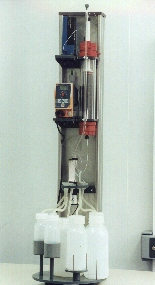Test Methods
pH DEPENDENCE LEACHING TEST
 pH Dependence leaching test ANC PrEN 14429 pH stat PrEN 1499 |
The test consists of parallel extractions of the material at an L/S=10 (l/kg) for 48 hours at a series of pre-set pH values. pH is one of the main leaching controlling parameters. The information can be used for geochemical speciation modelling, to evaluate high sensitivity (steep concentration - pH slopes) and to provide information on the sensitivity of leaching under externally imposed changes in pH (natural or caused by treatment) in specific field scenarios. In addition, the test provides a measure of acid/base neutralization capacity (ANC/BNC). Advantages & use
COLUMN LEACHING TEST
 Percolation test PrEN 14405 |
The column test is run in up-flow mode. The leachant is demineralised water (DMW). The test material should have a particle size < 4mm. Seven eluate fractions are collected within the range of L/S = 0.1-10 l/kg. The total test duration is approximately 21 days. In ISO TC 190/SC7/WG 6 a percolation leaching test similar to CEN/TS 14405 (inorganic) is in development (ISO/AWI 21268-3). This procedure addresses both inorganic and organic contaminants. Advantages & use
TANK LEACH TEST
 Tank leaching test NEN7345 |
In the test a monolithic specimen is subjected to leaching in a closed tank to evaluate surface area related release. The leachant demineralised water is renewed after 8 hours and 1, 2, 4, 9, 16, 36, 64 days using a leachant to product volume ratio (L/V) of 5. The results are expressed in mg/m2. Advantages & use
COMPACTED GRANULAR LEACH TEST
This test resembles the tank leach test for monolithic materials in the way it is carried out and the data are handled. The method is designed for granular materials that behave as a monolith in the scenario under investigation (e.g. clay lens in a sandy soil)